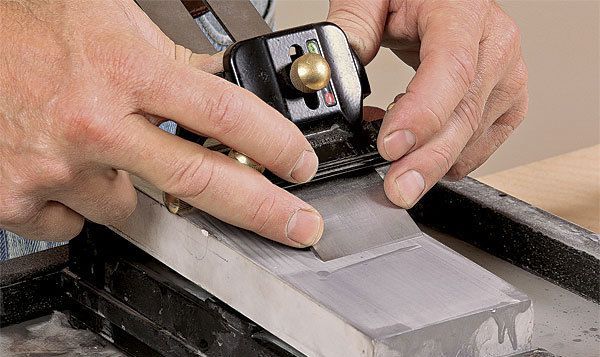Tool Test: Waterstones
They're the best choice for honing sharp edges
Synopsis: Synthetic waterstones are widely available and are more affordable than natural stones, but they have a reputation for dishing quickly, which spoils the flat surface you need for sharpening. So we tested nine stones from leading manufacturers to see how well they held up under repeated sharpenings, how easy they were to flatten, how quickly they honed, and whether they left a surface free of tearout, rough grain, or other defects.
Models tested include 1,000, 4,000, and 8,000 grits from Bester/Imanishi, Bester/Kitayama, King, Naniwa Chosera, Naniwa Superstone, Norton, Shapton, Sigma Power, and Sigma Power Select II.
From Fine Woodworking #224
After many years of experimentation, there’s no doubt in my mind that waterstones are the best choice for honing chisels and handplane blades. They produce a finer polish than both oil and diamond stones, and are more durable and less expensive (in the long run) than sandpaper.
Natural waterstones have been quarried for centuries and have always been highly prized, but the supply has diminished. Good ones are difficult to find and can be very expensive. However, synthetic waterstones are widely available and more affordable. There are so many for sale at woodworking stores, in catalogs, and online, that it’s not easy to know which one to buy. In fact, that’s why the editors at Fine Woodworking asked me to test them.
Bear in mind that waterstones are best used for honing a small, secondary bevel, not grinding the primary one. So, I looked at the three grits I use to hone: 1,000, 4,000, and 8,000. Some manufacturers don’t make stones in those exact grits, so I used an equivalent grit in those cases. Also, one set had only two stones (1,200-grit and 8,000-grit) based on the recommendation of the retailer.
Synthetic waterstones have a reputation for dishing quickly, and you can’t get a flat, straight cutting edge from a dished stone. So, the first thing I evaluated was how quickly they dished and how fast I could re-flatten them. I then tested how quickly they sharpened both O1 (standard high-carbon tool steel) and A2 (a tougher alloy) blades. Finally, I used them to sharpen plane and chisel blades, and used those tools to take shavings from end and edge grain, as the ultimate real-world test.
To see how quickly the stones dish, I based my methods on the elegantly simple ways that Lee Valley tests the waterstones they are considering for sale. I started by flattening the stones with a diamond lapping plate. Then I measured their height with a dial indicator. Next, I took the stones over to my workbench, and dished them with a plane blade (see photos, above). After that, I measured the stones’ height again, which told me how much material had been removed. All of the 1,000-grit stones dished. However, none of the 8,000-grit stones dished enough for me to measure, which means you won’t need to flatten them as often.
After the stones were dished, I flattened them with the diamond lapping plate, counting the number of strokes it took to do it. Because the 8,000-grit stones showed no measurable dishing, I didn’t do the flattening test on them.
For the full article, download the PDF below.
Fine Woodworking Recommended Products

Norton Water Stones

Olfa Knife























Log in or create an account to post a comment.
Sign up Log in